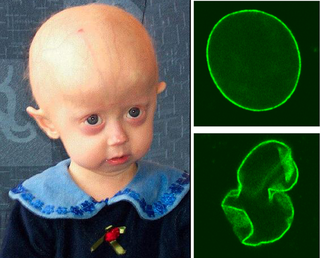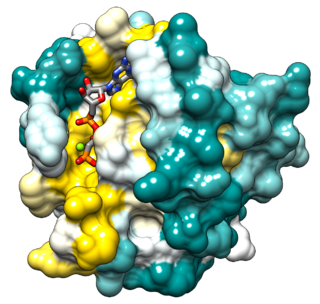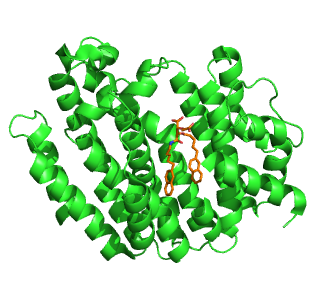
Lipid-anchored proteins are proteins located on the surface of the cell membrane that are covalently attached to lipids embedded within the cell membrane. These proteins insert and assume a place in the bilayer structure of the membrane alongside the similar fatty acid tails. The lipid-anchored protein can be located on either side of the cell membrane. Thus,the lipid serves to anchor the protein to the cell membrane. They are a type of proteolipids.

Progeria is a specific type of progeroid syndrome,also known as Hutchinson-Gilford syndrome. Progeroid syndromes are a group of diseases that causes individuals to age faster than usual,leading to them appearing older than they actually are. Patients born with progeria typically live to an age of mid-teens to early twenties.

Ras,from "Rat sarcoma virus",is a family of related proteins that are expressed in all animal cell lineages and organs. All Ras protein family members belong to a class of protein called small GTPase,and are involved in transmitting signals within cells. Ras is the prototypical member of the Ras superfamily of proteins,which are all related in three-dimensional structure and regulate diverse cell behaviours.

The farnesyltransferase inhibitors (FTIs) are a class of experimental cancer drugs that target protein farnesyltransferase with the downstream effect of preventing the proper functioning of the Ras (protein),which is commonly abnormally active in cancer.

Prenylation is the addition of hydrophobic molecules to a protein or chemical compound. It is usually assumed that prenyl groups (3-methylbut-2-en-1-yl) facilitate attachment to cell membranes,similar to lipid anchors like the GPI anchor,though direct evidence of this has not been observed. Prenyl groups have been shown to be important for protein–protein binding through specialized prenyl-binding domains.
Farnesyltransferase is one of the three enzymes in the prenyltransferase group. Farnesyltransferase (FTase) adds a 15-carbon isoprenoid called a farnesyl group to proteins bearing a CaaX motif:a four-amino acid sequence at the carboxyl terminus of a protein. Farnesyltransferase's targets include members of the Ras superfamily of small GTP-binding proteins critical to cell cycle progression. For this reason,several FTase inhibitors are undergoing testing as anti-cancer agents. FTase inhibitors have shown efficacy as anti-parasitic agents,as well. FTase is also believed to play an important role in development of progeria and various forms of cancers.
In molecular biology,extracellular signal-regulated kinases (ERKs) or classical MAP kinases are widely expressed protein kinase intracellular signalling molecules that are involved in functions including the regulation of meiosis,mitosis,and postmitotic functions in differentiated cells. Many different stimuli,including growth factors,cytokines,virus infection,ligands for heterotrimeric G protein-coupled receptors,transforming agents,and carcinogens,activate the ERK pathway.

Tipifarnib is a farnesyltransferase inhibitor. Farnesyltransferase inhibitors block the activity of the farnesyltransferase enzyme by inhibiting prenylation of the CAAX tail motif,which ultimately prevents Ras from binding to the membrane,rendering it inactive.

Acute myeloblastic leukemia with maturation (M2) is a subtype of acute myeloid leukemia (AML).

Squalene synthase (SQS) or farnesyl-diphosphate:farnesyl-diphosphate farnesyl transferase is an enzyme localized to the membrane of the endoplasmic reticulum. SQS participates in the isoprenoid biosynthetic pathway,catalyzing a two-step reaction in which two identical molecules of farnesyl pyrophosphate (FPP) are converted into squalene,with the consumption of NADPH. Catalysis by SQS is the first committed step in sterol synthesis,since the squalene produced is converted exclusively into various sterols,such as cholesterol,via a complex,multi-step pathway. SQS belongs to squalene/phytoene synthase family of proteins.

Ras homolog gene family,member B,also known as RHOB,is a protein which in humans is encoded by the RHOB gene.

Serine/threonine-protein kinase PLK1,also known as polo-like kinase 1 (PLK-1) or serine/threonine-protein kinase 13 (STPK13),is an enzyme that in humans is encoded by the PLK1 gene.

Zinc finger and BTB domain-containing protein 16 is a protein that in humans is encoded by the ZBTB16 gene.
In enzymology,a geranyltranstransferase is an enzyme that catalyzes the chemical reaction

Protein farnesyltransferase/geranylgeranyltransferase type-1 subunit alpha is an enzyme that in humans is encoded by the FNTA gene.

Ras-related protein R-Ras is a protein that in humans is encoded by the RRAS gene.

Protein farnesyltransferase subunit beta is an enzyme that in humans is encoded by the FNTB gene.

Progerin is a truncated version of the lamin A protein involved in the pathology of Hutchinson–Gilford progeria syndrome. Progerin is most often generated by a sporadic single point nucleotide polymorphism c.1824 C>T in the gene that codes for matured Lamin A. This mutation activates a cryptic splice site that induces a mutation in premature Lamin A with the deletion of a 50 amino acids group near the C-terminus. The endopeptidase ZMPSTE24 cannot cleave between the missing RSY - LLG amino acid sequence during the maturation of Lamin A,due to the deletion of the 50 amino acids which included that sequence. This leaves the intact premature Lamin A bonded to the methylated carboxyl farnesyl group creating the defective protein Progerin,rather than the desired protein matured Lamin A. Approximately 90% of all Hutchinson–Gilford progeria syndrome cases are heterozygous for this deleterious single nucleotide polymorphism within exon 11 of the LMNA gene causing the post-translational modifications to produce Progerin.
Xin Lu is a Professor of Cancer Biology and Director of the Ludwig Institute for Cancer Research at the University of Oxford. She is known for her discovery of and research on the ASPP family of proteins.

Patrick J. (Pat) Casey is a biochemist and molecular pharmacologist and is a James B. Duke Professor of Pharmacology and Cancer Biology at Duke University School of Medicine. In 2005,he relocated to Singapore to help found the Duke-NUS Medical School Singapore,where he continues to serve as its Senior Vice Dean of Research.














